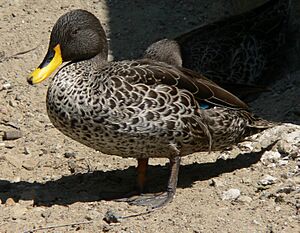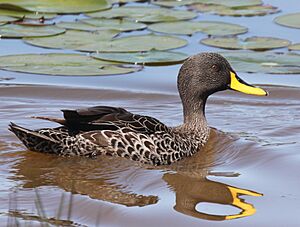Yellow-billed duck facts for kids
Quick facts for kids Yellow-billed duck |
|
|---|---|
 |
|
| Conservation status | |
| Scientific classification | |
| Genus: |
Anas
|
| Species: |
undulata
|
| Subspecies | |
|
|
The yellow-billed duck (Anas undulata) is a type of duck that lives in southern and eastern Africa. These ducks are about 51–58 cm long. They are very common and do not migrate long distances. Instead, they move around in the dry season to find water. Outside of breeding time, they often gather in large groups.
Contents
What They Look Like
Yellow-billed ducks are about the same size as a mallard. They are mostly grey with a darker head and a bright yellow bill. When they fly, their wings look whitish underneath. From above, their wings show a green patch called a speculum with white borders.
Male and female ducks look very similar. Young ducks are a bit duller than adults. The ducks from the north-eastern parts of Africa are darker. They also have a brighter bill and a blue speculum.
These ducks live in freshwater areas that are fairly open. They find food by dabbling, which means they dip their heads into the water to eat plants. They usually feed in the evening or at night. They build their nests on the ground in thick plants near water. Sometimes, you can even find them in towns, near golf courses, parks, or lakes. A female duck usually lays between six and twelve eggs.
The male yellow-billed duck makes a whistle sound, like a common teal. The female makes a quacking sound, similar to a mallard.
There are two types of yellow-billed ducks: A. undulata rueppelli (the northern yellow-billed duck) and A. undulata undulata (the southern yellow-billed duck). The yellow-billed duck is protected by an agreement called the Agreement on the Conservation of African-Eurasian Migratory Waterbirds (AEWA). The southern type of yellow-billed duck is becoming fewer in number. This is because they compete with and sometimes breed with wild mallards.
Yellow-billed Duck Life
Life Expectancy
Male and female yellow-billed ducks live for different amounts of time. On average, male ducks live for about 4 years and 4 months. Female ducks live for just over 3 years. This means males tend to survive longer each year. About 79% of males survive each year, while about 72% of females do.
The survival rate for young ducks changes a lot each year. But on average, about 67% of young ducks survive. Most deaths for yellow-billed ducks happen in the summer months. December usually has the highest death rate, followed closely by January.
Courtship
Male yellow-billed ducks perform many special moves to attract a female. These are called courtship displays. They are similar to what other African ducks do. In fact, yellow-billed ducks perform more courtship displays than many other African ducks. Scientists have seen seven main types of courtship displays in African ducks. Most species don't do all seven, but the yellow-billed duck does all of them!
Since male and female yellow-billed ducks look very similar and don't have super colorful feathers, these fancy displays might be how they show off to each other.
Molt
Like most other water birds, yellow-billed ducks go through a molting process. During this time, they lose all their flight feathers at once. This means they cannot fly for about three to four weeks. This makes them very easy targets for predators. It also makes it hard for them to find food.
Yellow-billed ducks lose a lot of body weight (about a quarter) during the first half of molting. But they are able to gain all that weight back by the end of the molt. This is different from most other African water birds, which usually end the molt lighter than before. This suggests that yellow-billed ducks can move around better even when they are partly molted. This helps them find food even before their new flight feathers are fully grown.
Threats to Yellow-billed Ducks
Hunting
Even though yellow-billed ducks are protected by the African-Eurasian Migratory Waterbirds Agreement, they can still be hunted. However, hunters are not allowed to use lead shot. Hunting seasons are planned so they don't happen during the breeding season, which is usually around July. But the exact breeding season can change each year depending on the weather. Hunting is a big reason why yellow-billed ducks die. Studies have shown that over 25% of duck deaths were due to shooting.
Hybridization
In the middle of the 1900s, mallards were brought to Africa. As more and more mallards arrived, people became worried. They feared that mallards might breed with yellow-billed ducks, creating hybrids (mixed species). This worry comes from other places in the world where mallards, which are an invasive species, have caused other native ducks to disappear because of interbreeding.
Some people have seen ducks that look like they might be a mix of yellow-billed ducks and other native ducks. This has made the worry about hybridization even bigger. However, scientists haven't done enough genetic tests to confirm if these ducks are truly hybrids.
Even with genetic tests, it's still hard to know for sure if hybridization is happening. Scientists are still debating if mallards and yellow-billed ducks are breeding together. Two recent studies (from 2019 and 2020) that looked at DNA came to different conclusions. One said it was happening, and the other said it wasn't.
However, most scientists agree that even if mallards and yellow-billed ducks do breed, it's unlikely to change the yellow-billed duck's genes much in the long run. This is because if mixing happens, the mallard's genes are mostly affected, while the yellow-billed duck's genes stay mostly the same.
Images for kids




